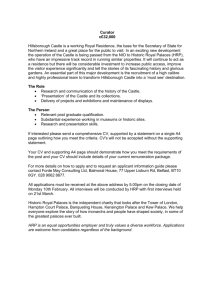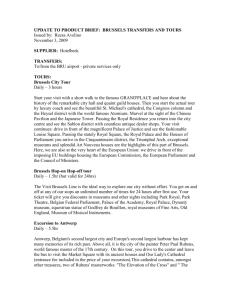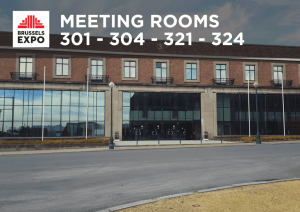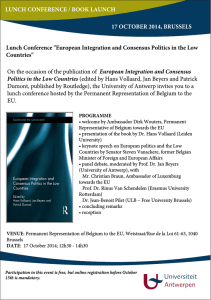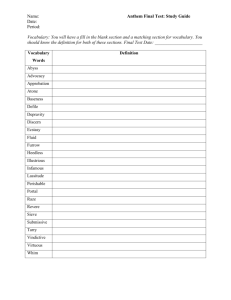Belgium Sightseeing Facts
advertisement
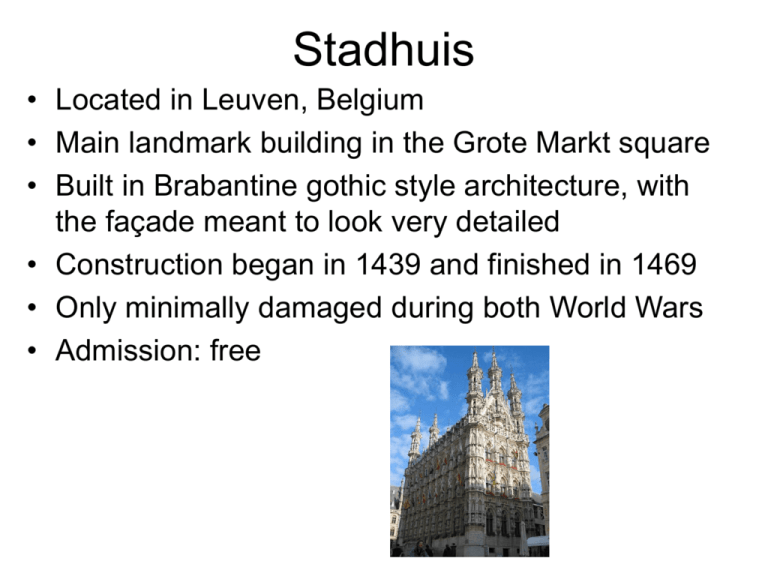
Stadhuis • Located in Leuven, Belgium • Main landmark building in the Grote Markt square • Built in Brabantine gothic style architecture, with the façade meant to look very detailed • Construction began in 1439 and finished in 1469 • Only minimally damaged during both World Wars • Admission: free Parc du Cinquantenaire Jubelpark • Most buildings in the park were built for the 1880 National Exhibition • The park was established to commemorate the 50th anniversary of Belgium’s independence • 1905: Triumphal Arch built, using iron, glass, and stone • The Royal Military Museum, Cinquantenaire Art Museum, and AutoWorks Museum are located in inside the park • Originally, the area was part of the military exercising grounds • The Great Mosque of Brussels is located in the park, and is the oldest mosque in Brussels Kasteel van Beersel • • • • • • Located in town of Beersel Original purpose was as a defensive base for Brussels Constructed between 1300 and 1310 1818: a cotton factory occupied the fortress Built of red bricks, rather than stones Flat land forced the creation of a large moat, high walls, and impressively tall towers • Looks the same as it did at the end of the 15th century • Currently, does not serve as a private residence • Admission Belgian Comic Strip Center • Housed in the former Waucquez Warehouse, designed by Victor Horta • Opened to the public on 6 October 1989 • Also serves as a modern research centre, with over 40,000 titles in more than 20 languages • Non-profit organization • Aim of Center: maintain the building’s integrity and promote the comic strip as a valuable cultural medium • Belgium alone has over 700 comic strip authors • Comics from Belgium: Tintin, Spirou, Bob and Bobette, the Smurfs, Lucky Luke, Blake and Mortimer • Admission: free to €8 Gravensteen • • • • • • • • • • A castle located in Ghent Gravensteen means “castle of the count” in Dutch Built in 1180 by count Philip of Alsace Prior to its construction, there was a wooden castle in the same location Castle has been used as a courthouse and a prison 1885: City of Ghent bought the castle and started renovation The walls and the dungeon were restored to their original condition Partially surrounded by a moat today There is a museum inside the castle Admission: free to €8 Atomium • • • • Built for the World Fair in Brussels in 1958 The symbol of Europe’s capital 8 levels, spread over 5 spheres are open to the public Permanent exhibition dedicated to Expo58 are on 2 levels • Temporary exhibitions devoted to architecture, design, and society are the other 3 levels • In the upper sphere is the Panorama, which offers awesome views of Brussels, as well as the Panoramic Restaurant • Entrance fee: €6 to €11 MIM (Musical Instruments Museum • Created on 1 February 1877; then attached to the Brussels Royal Music Conservatory • Original Purpose: Showing early instruments to students attending the Conservatory • 11 January 1992: Became part of the Royal Museums of Art and History as Department VI • Gained international recognition for the quantitative importance of its collections, as well as their diversity and for the quality and rarity of the items • Collections have over 8,000 instruments • Admission: Free to €5 Coudenberg • Coudenberg means cold hill • A small hill where the Palace of Coudenberg was built • For about 700 years, it served as the seat of government of counts, dukes, archdukes, kings, emperors and governors • The archeological vestiges of the palace and its foundations are currently open to the public • 1183: Ducky of Brabant created by the German Emperor Frederik Barbarossa • Coudenberg was included within the first great wall built around Brussels • Remains of the ancient palace and adjacent building have been excavated below present ground level and preserved with a partial concrete cover • You can visit the remains via the Bellevue Museum Königlicher Palast von Brüssel • The official palace of the King of the Belgians • Not used as a royal residence because the king and his family live in the Royal Castle of Laeken • Located in front of Brussels Park • Construction began in 1783 and was finished in 1934 • Where the current palace stands was once part of Coudenberg Palace, which dated back to the Middle Ages • Coudenberg Palace was where the Dukes of Brabant lived • February 3, 1731: Coudenberg Palace destroyed by a fire Grote Markt/Grand Place • The central square of Brussels • The most important tourist destination in Brussels, with the most memorable landmark • Surrounded by guildhalls, Town Hall, and the Breadhouse • A UNESCO World Heritage Site (1998) • Every two years in August, a “flower carpet” is set up. A million begonias are set up in patterns (area 79x253 feet)

